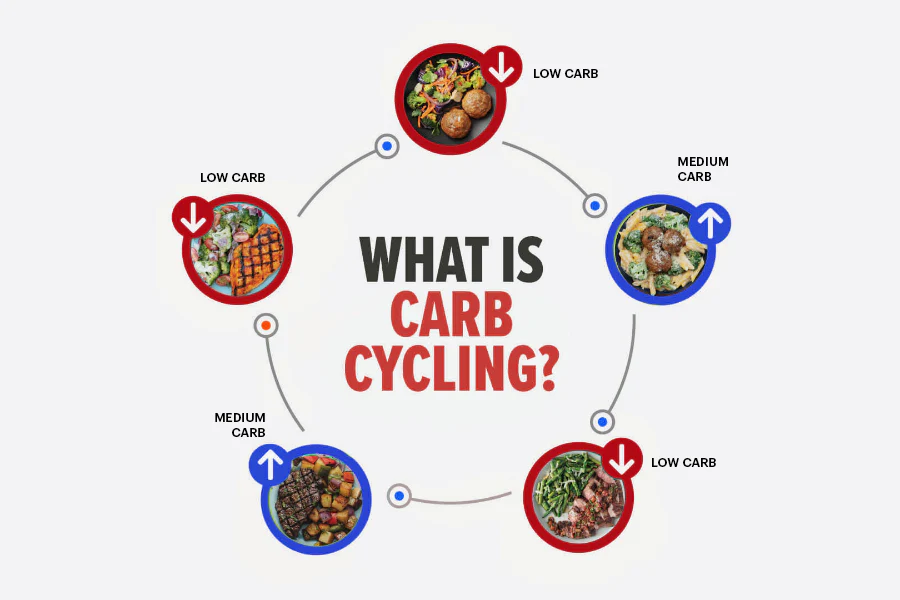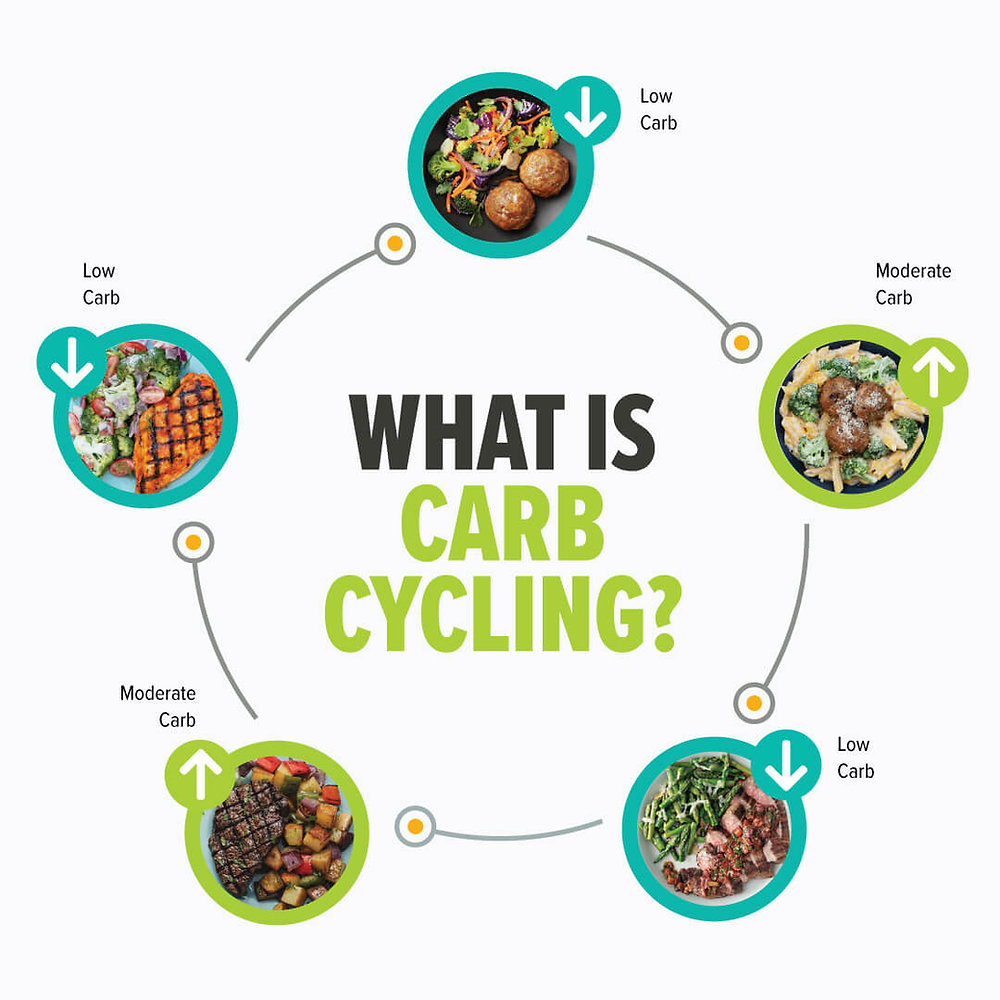
Carb Cycling: A Comprehensive Guide to Optimizing Your Nutrition and Fitness

Carb cycling is a popular dietary approach that involves strategically adjusting carbohydrate intake to optimize energy levels, enhance athletic performance, and promote fat loss. This comprehensive guide will provide you with all the information you need to understand carb cycling, its benefits, and how to implement it into your nutrition and fitness routine effectively. Whether you’re an athlete looking to improve performance or someone seeking to optimize their body composition, carb cycling can be a valuable tool in achieving your goals.
1. Understanding Carb Cycling
Carb cycling involves alternating between periods of higher carbohydrate intake and lower carbohydrate intake throughout the week or month. The goal is to strategically time carbohydrate consumption to optimize performance, improve body composition, and support overall health. Carb Cycling
2. How Carb Cycling Works
Carb cycling works by manipulating carbohydrate intake to influence insulin levels, glycogen storage, and metabolic flexibility. On high carb days, the increased carbohydrate intake replenishes glycogen stores and provides energy for intense workouts. On low carb days, the body is encouraged to use stored fat as a fuel source.
3. Benefits of Carb Cycling
Carb cycling offers several potential benefits:
Improved athletic performance: By strategically timing carbohydrate intake, carb cycling can enhance performance during high-intensity workouts and endurance activities.
Optimized fat loss:
Lower carbohydrate intake on specific days promotes fat burning and can aid in achieving a calorie deficit for weight loss. Carb Cycling
Preserved muscle mass:
By providing adequate carbohydrates on high carb days, carb cycling helps maintain muscle glycogen stores, which can support muscle recovery and growth.
Better metabolic flexibility:
Alternating between high and low carb days can enhance the body’s ability to switch between using carbohydrates and fat as fuel sources.
Enhanced nutrient partitioning: Carb cycling can improve how the body utilizes and stores nutrients, promoting optimal nutrient absorption and utilization.
4. Implementing Carb Cycling: The Basics
To implement carb cycling, you’ll need to determine your carb cycling schedule, which includes the number of high and low carb days per week or month. It’s essential to consider your activity levels, goals, and individual preferences when creating your plan. Carb Cycling
5. Determining Your Carb Cycling Schedule
Your carb cycling schedule will depend on various factors, such as your activity level, body composition goals, and personal preferences. Some individuals may prefer a weekly schedule with alternating high and low carb days, while others may opt for a monthly approach.
6. Types of Carb Cycling
There are different approaches to carb cycling, including:
Traditional carb cycling: This method involves alternating between high and low carb days throughout the week.
Weekly refeed: In this approach, a specific day of the week is dedicated to a higher carb intake, providing a psychological and physiological break from low carb days.https://fitnzoid.com/metcon-the-ultimate-guide-to-metabolic-conditioning-for-optimal-fitness/
Targeted carb cycling: This method involves consuming additional carbohydrates around workouts to support performance and recovery. Carb Cycling
7. Structuring Your High Carb Days
On high carb days, you’ll increase your carbohydrate intake to replenish glycogen stores and support intense physical activity. Focus on consuming complex carbohydrates from sources such as whole grains, fruits, and starchy vegetables.
8. Structuring Your Low Carb Days
On low carb days, you’ll reduce your carbohydrate intake to encourage the body to utilize stored fat as fuel. Emphasize consuming lean protein, healthy fats, and fibrous vegetables to maintain satiety and provide essential nutrients.
9. Adjusting Macronutrient Ratios
Along with manipulating carbohydrate intake, you’ll also need to adjust your macronutrient ratios on high and low carb days. On high carb days, increase your carbohydrate intake while moderating fat intake. On low carb days, prioritize healthy fats and lean protein while keeping carbohydrate intake lower.
10. Choosing Healthy Carb Sources
When practicing carb cycling, it’s important to choose nutrient-dense, whole food sources of carbohydrates. Examples include quinoa, sweet potatoes, brown rice, oats, and fruits. Avoid processed and refined carbohydrates.
11. Monitoring and Tracking Progress
To determine the effectiveness of your carb cycling approach, it’s crucial to monitor and track your progress. Keep a record of your performance, energy levels, body measurements, and any changes in body composition. Adjust your plan as necessary based on your observations. Carb Cycling
12. Carb Cycling and Exercise Performance
Carb cycling can have a significant impact on exercise performance. By strategically timing carbohydrate intake, you can optimize glycogen stores and energy availability, leading to improved endurance, strength, and recovery. Carb Cycling
13. Potential Drawbacks and Considerations
While carb cycling can be beneficial, it’s important to consider individual differences and potential drawbacks. Some individuals may not respond well to low carb days, and others may find it challenging to adhere to the schedule. It’s crucial to listen to your body and make adjustments as needed.
Frequently Asked Questions (FAQs)
Can anyone try carb cycling?
Carb cycling can be beneficial for individuals who are physically active and have specific performance or body composition goals. It’s recommended to consult with a healthcare professional or registered dietitian before starting any new dietary approach.
Is carb cycling suitable for weight loss?
Carb cycling can support weight loss by promoting fat burning and creating a calorie deficit. However, it’s essential to consider overall calorie intake and ensure a balanced diet for sustainable weight loss.
Can I personalize my carb cycling plan?
Yes, you can personalize your carb cycling plan based on your goals, activity level, and individual preferences. Experiment with different approaches and adjust as needed.
Are there any risks associated with carb cycling?
For most healthy individuals, carb cycling is safe. However, individuals with specific medical conditions or dietary restrictions should consult with a healthcare professional before adopting carb cycling. Carb Cycling
How long should I practice carb cycling?
The duration of carb cycling can vary based on individual goals and preferences. Some individuals may practice it for a few weeks or months, while others may incorporate it as a long-term dietary approach.
Is carb cycling good for fat loss?
Yes, carb cycling can be an effective strategy for fat loss. Carb cycling involves alternating between high-carbohydrate days and low-carbohydrate days, strategically timing carbohydrate intake to maximize fat burning while preserving muscle mass.
What is proper carb cycling?
Proper carb cycling involves strategically alternating between high-carbohydrate days and low-carbohydrate days to achieve specific goals such as fat loss, muscle gain, or improved athletic performance. Here are the key principles to follow for effective carb cycling
What are the disadvantages of carb cycling?
While carb cycling can be an effective approach for many individuals, it’s important to consider potential drawbacks and limitations. Here are some disadvantages of carb cycling to be aware of
Does carb cycling put you in ketosis?
Carb cycling does not necessarily put you in ketosis. Ketosis is a metabolic state in which your body primarily relies on ketones, produced from fat breakdown, as its main source of fuel due to a very low carbohydrate intake Carb Cycling
Conclusion
Carb cycling can be a powerful tool for optimizing nutrition and fitness. By strategically adjusting carbohydrate intake, you can enhance athletic performance, promote fat loss, and improve metabolic flexibility. Remember to personalize your carb cycling plan, monitor progress, and listen to your body’s feedback. If you’re unsure about implementing carb cycling, consult with a healthcare professional or registered dietitian who can provide personalized guidance.





Vital Proteins Collagen Peptides: Unlocking the Secrets to Radiant Skin and Healthy Joints - FITNZOID
[…] we will delve into the science behind Vital Proteins Collagen Peptides and explore their potential impact on our overall well-being. Vital Proteins Collagen […]
Beginner Gym Workout for Teenage Females - FITNZOID
[…] you a teenage girl looking to start your fitness journey? Congratulations on taking the first step towards a healthier lifestyle! Engaging in regular exercise not only […]